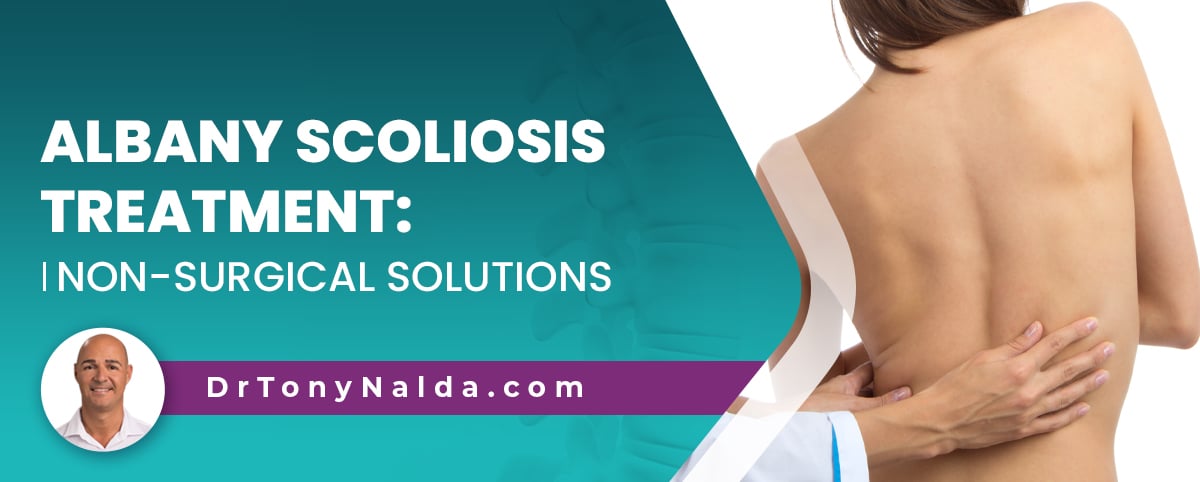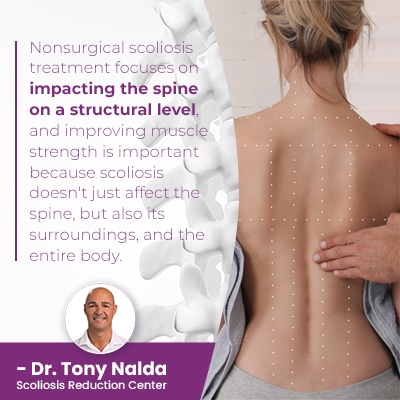Albany Scoliosis Treatment: Non-Surgical Solutions

Nonsurgical treatment solutions for scoliosis offer an alternative to invasive spinal fusion surgery; scoliosis surgery can address progression and straighten a bent spine, but it can also cost the spine in terms of its overall health, strength, and function.
A 3-hour flight from Albany to Orlando can put patients within reach of a renowned nonsurgical scoliosis treatment provider, Dr. Tony Nalda, of the Scoliosis Reduction Center®. Scoliosis can be treated surgically or nonsurgically; nonsurgical treatment is safer, less invasive, and better for spinal health and function.
There is more than one way to treat scoliosis, and it's important to know the differences because different types of treatment affect the spine differently.
Table of Contents
What is Scoliosis?
Scoliosis is an unnatural sideways curvature of the spine that also rotates, and as a progressive spinal condition, its nature is to get worse over time, and this means the size of the unnatural spinal curve is going to increase.
As scoliosis progresses, the condition's uneven forces are increasing as are their effects.
Scoliosis is an asymmetrical condition that disrupts the body's overall symmetry, and with current estimates at close to seven million people living with the condition in the United States alone, it is highly prevalent.
What Causes Scoliosis?
In most cases of scoliosis, we don't know the cause, and this is known as idiopathic scoliosis: not clearly associated with a single-known cause.
Idiopathic scoliosis is thought to be multifactorial: caused by a number of different factors, or a combination of factors, that can vary from person to person.
Approximately 80 percent of known cases are classified as idiopathic scoliosis, and the remaining 20 percent is associated with known causes and are considered atypical: neuromuscular scoliosis, congenital scoliosis, and degenerative scoliosis.
These types are considered atypical because an underlying pathology is causing them to develop, and they can involve curves that bend to the left, towards the heart, and in typical cases of idiopathic scoliosis, curves bend to the right, away from the heart.
Neuromuscular scoliosis is caused by the presence of a larger neuromuscular condition such as spina bifida, muscular dystrophy, and cerebral palsy.
Congenital scoliosis is caused by a malformed spine that develops in utero, and degenerative scoliosis is caused by natural age-related spinal degeneration and the cumulative effect of certain lifestyle factors: carrying excess weight, low activity levels, chronic poor posture, excessive consumption of alcohol and/or smoking, and repeatedly lifting heavy objects incorrectly and straining the spine.
Scoliosis can affect the body in a number of ways, and each patient's experience will be unique and shaped by a number of variables.
Scoliosis Severity
Scoliosis ranges widely in severity from mild scoliosis to moderate, severe, and very severe scoliosis.
Condition severity is determined by a measurement known as Cobb angle, and this is taken during X-ray and involves drawing lines from the tops and bottoms of the curve's most-tilted vertebrae; the resulting angle is expressed in degrees.
The higher the Cobb angle, the more severe the condition:
- Mild scoliosis: Cobb angle of between 10 and 25 degrees
- Moderate scoliosis: Cobb angle of between 25 and 40 degrees
- Severe scoliosis: Cobb angle of 40+ degrees
- Very-severe scoliosis: Cobb angle of 80+ degrees
 Part of the reason scoliosis is deemed a complex condition to treat is its progressive and 3-dimensional nature and because no two cases are the same.
Part of the reason scoliosis is deemed a complex condition to treat is its progressive and 3-dimensional nature and because no two cases are the same.
Scoliosis is an incurable condition, so treatment is more about managing an ongoing condition; it can be worth traveling to access world-renowned scoliosis treatment because how scoliosis is treated will shape the spine's long-term health; spinal health, in return, factors into a person's quality of life.
So for residents of Albany, New York who are interested in what Orlando, Florida's Scoliosis Reduction Center® has to offer, a 3-hour flight, or a road trip traversing 1,219 miles, can put one in reach.
Regardless of type or severity, the best time to start scoliosis treatment is always now, and a proactive response to a scoliosis diagnosis is one of the benefits of conservative treatment offered at the Center; being proactive prioritizes preventing progression, increasing condition effects, and the need for invasive surgical treatment in the future.
Even scoliosis that's diagnosed as mild isn't guaranteed to stay there, not without the help of a proactive treatment approach.
The Benefits of Non Surgical Treatments for Scoliosis
Scoliosis surgery can be invasive, and there are many benefits of nonsurgical treatment for scoliosis.
The spine is a key structure of human anatomy; it facilitates movement, brain-body communication, and protects important organs.
A spine that has its natural curves in place is one that's aligned and can function optimally, but if one or more healthy spinal curves are lost, the biomechanics of the entire spine are disrupted.
The biggest benefit to nonsurgical scoliosis treatment is that it's proactive; scoliosis can be highly treatable, and it's most treatable while mild.
Progression makes the spine increasingly rigid, and this makes it less responsive to treatment and can also make it difficult for some patients to perform key therapeutic exercises as part of treatment.
When treatment is started immediately, the condition is going to be at its mildest and most responsive.
As scoliosis progresses, the condition's effects become more overt, and in most cases, it's more effective to work towards preventing increasing effects than it is to attempt to reverse effects once they're established.
The sooner treatment is started, the better, and conservative nonsurgical treatment includes chiropractic care, physical therapy, corrective bracing, and rehabilitation.
Curvature Reductions
Scoliosis is a structural spinal condition, meaning there is a structural abnormality within the spine itself, so first and foremost, to be treated effectively, conditions have to be impacted on a structural level.
Condition-specific chiropractic care works towards reducing the size of the unnatural spinal curvature through a series of techniques and manual adjustments that can adjust the position of the curve's most-tilted vertebrae.
When treating scoliosis in adolescents, a focus is on reducing curves and holding the reduction despite the constant trigger of growth.
When tilted vertebrae are realigned with the spine, its structure is improved, and improved muscle strength is important for holding that reduction.
Physical Therapy
Physical therapy and scoliosis exercises can help increase core strength so the spine's surrounding muscles can optimally support and stabilize the spine.
It's not just the spine that has to maintain its natural curves and alignment; it's also the role of the spine's surrounding muscles.
Muscle weakness and a muscular imbalance is associated with scoliosis, and nonsurgical treatment works towards strengthening and balancing abdominal muscles.
A muscular imbalance can develop as an unnaturally curved spine pulls the spine in different directions; the muscles on one side of the spine can be weak from underuse, while the muscles on the opposite side can be stretched and sore from overuse.
Physical therapy can also help improve posture and activates certain areas of the brain to stimulate brain-body communication and improve body-positioning.
Nonsurgical scoliosis treatment focuses on impacting the spine on a structural level, and improving muscle strength is important because scoliosis doesn't just affect the spine, but also its surroundings, and the entire body.
Scoliosis Bracing and Rehabilitation
 Corrective bracing is a modern approach to augmenting corrective treatment results by pushing the spine into a corrective position.
Corrective bracing is a modern approach to augmenting corrective treatment results by pushing the spine into a corrective position.
A corrective brace addresses the condition's 3-dimensional nature so can help treat scoliosis, when combined with other types of corrective treatment.
No one facet of treatment is enough to impact scoliosis on all levels, but when multiple scoliosis-specific treatment disciplines are integrated into a customized plan, scoliosis can be very responsive.
Rehabilitation can involve continued chiropractic care and a series of custom-prescribed home exercises to continue healing and stabilizing the spine.
Rehabilitation is about holding treatment results for the long term.
Conclusion
Those in need of Albany scoliosis treatment can access what Dr. Tony has to offer patients of the Scoliosis Reduction Center® within a 3-hour flight to Celebration, Florida.
Scoliosis patients need to understand that not all cases of scoliosis need surgery; in fact, the results of conservative treatment speaks for itself.
Younger patients with scoliosis need to be taken seriously because progression is triggered by growth, so curve progression tends to be faster in patients who have not yet reached skeletal maturity.
Diagnosing scoliosis is achieved through a combined physical examination and the results of a scoliosis X-ray.
Scoliosis affects all ages from babies to the elderly and every age in between, and regardless of type or severity, being proactive with treatment is key to preventing progression and sparing patients the hardships of invasive surgical treatment in the future.
An abnormal curvature of the spine always needs to be taken seriously, particularly when it's progressive.
For those interested in proactive nonsurgical scoliosis treatment, don't hesitate to reach out; it can be the first step on the road to treatment success.
Dr. Tony Nalda
DOCTOR OF CHIROPRACTIC
After receiving an undergraduate degree in psychology and his Doctorate of Chiropractic from Life University, Dr. Nalda settled in Celebration, Florida and proceeded to build one of Central Florida’s most successful chiropractic clinics.
His experience with patients suffering from scoliosis, and the confusion and frustration they faced, led him to seek a specialty in scoliosis care. In 2006 he completed his Intensive Care Certification from CLEAR Institute, a leading scoliosis educational and certification center.
About Dr. Tony Nalda
 Ready to explore scoliosis treatment? Contact Us Now
Ready to explore scoliosis treatment? Contact Us Now





